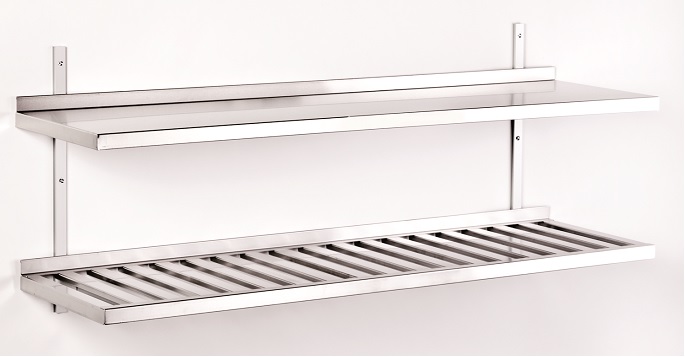The shelves are made of 18/8 steel and the wall rails and brackets of anodised aluminium.
The racks are custom designed to meet the user’s needs, so the number of shelves can be freely chosen.
The shelves are made of 18/8 steel and the wall rails and brackets of anodised aluminium.
The racks are custom designed to meet the user’s needs, so the number of shelves can be freely chosen.
Our wall racks can be freely adjusted.
The rack shelves can be perforated plate, grate or solid plate shelves, from which it is easy to choose a combination that best suits the intended use.
The wall rails and brackets of the racks are made of anodised aluminium.
 Wall rack with a solid plate and a grate shelf
Wall rack with a solid plate and a grate shelf
The wall racks are made to customer-defined shelf lengths. Racks with a length in excess of 2,800 mm are made of several components. The shelf length determines the number of wall rails and shelf brackets. The standard depths for shelves are 250, 300, 350 and 400 mm.
Shelf brackets are also available in a more robust design for applications where the shelves are required to bear a heavier load. For shelves deeper than those listed above, a floor rack is recommended.
It is advisable to check the dimensions of the rack (length x width x height) as well as the type of the shelf plates when placing the order. The standard widths are 250, 300, 350 and 400 mm. Shelf brackets are also available in a more robust design for applications where the shelves are required to bear a heavier load. If you already know that the shelves will be required to bear a heavier load, it is worthwhile to mention this when placing your order.
CLEANING
Stainless steel equipment and fixtures must be cleaned on a regular basis to prevent them from rusting. A water wash is often sufficient for cleaning a stainless steel surface; hot water and steam can be used in special cases.
Impurities and deposits that have adhered to the surface can be removed by rubbing them with an emery cloth, for example. NOTE! The emery cloth must be non-ferrous. It is advisable to first try the treatment on a less noticeable part of the product.
DETERGENTS
Standard cleaning powders or power detergents such as soda, borax or sodium perborate can be used for cleaning stainless steel surfaces.
Alkaline solutions, such as soda, ammonia and diluted soda lye, can be used for dissolving grease. Acetone, petrol, alcohol and similar organic solvents can also be used for removing grease deposits or other water-insoluble matter.
Detergents that contain sulphuric or hydrochloric acid may not be used for cleaning stainless steel surfaces.
DISINFECTION
The sterilising agents used for disinfection often contain sodium hypochlorite or potassium hypochlorite. However, these substances are dangerous to stainless steel as they easily give rise to pitting corrosion. Other disinfectants that contain chlorine, such as chloramines, are also dangerous. The most affordable disinfectant that is suitable for stainless steel is nitric acid; even mild concentration solutions have a bactericidal effect.
TREATMENT AFTER CLEANING
The detergent must be carefully cleaned from the steel surface. Rinsing with plenty of water is usually sufficient for this purpose. If acidic detergents are used, a pre-rinse should be carried out with a neutralising solution, such as soda.
The user must always ensure that the room concerned is sufficiently ventilated, proper protective gear is used and any in-house occupational heath and safety instructions are complied with.